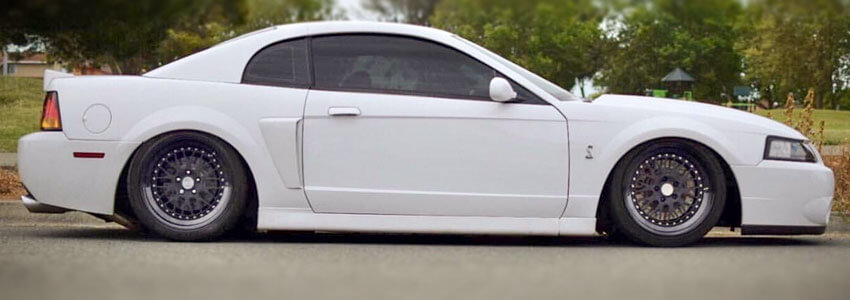
In Mustang history, many models set the stage for the competition to benchmark amongst their products.
Since 1964, the original American pony car has invigorated an entire nation and enthusiasts
worldwide. After the wildly successful reign of the Fox Body Mustang during 1979-1993, Ford knew that to
keep the legendary nameplate moving in the right direction, Mustang engineers and designers needed a
revolutionary design that would harken back the original 60s era pony. In 1994, Ford unveiled the
fourth-generation Mustang in the SN95, to push the boundaries of what a Mustang could be.
Unlike its Fox Body counterpart, the SN95 (1994-1998) and New Edge (1999-2004) is a more edgy sculpted
design that took direct cues from past Mustang models such as 1967 Mustang GT Fastback, 1969 Mustang
Mach 1, and 1969 Boss 429. The long hood, short deck, and wide stance is a direct lineage from the
entire heritage of Mustangs. Just like these legendary Mustang models, each of them pushed the
boundaries of engine performance technology. Thanks to the legendary Fox Body halo Mustang in the 1993
Cobra & Cobra R, it helped establish the long legacy in the modern age of Ford Mustang performance.
Throughout the fourth generation of America's pony car, it brought some of the most lethal stallions and
serpents to ever come out of Dearborn, Michigan.
In this guide, you will find all of the vital information, facts, and specifications on all of the
engines that helped make the 1994-2004 Mustang, one of the most beloved generations in the history of
America's favorite pony car!
1994-1995 Mustang GT 5.0L V8
1995 Cobra R 5.8L V8
1996-2004 Mustang GT 4.6L V8
1996-2001 4.6L 32V V8 Cobra
2000 5.4L 32V V8 Cobra R
2003-2004 Mach 1 4.6L 32V V8 "Shaker"
Cobra "Terminator" 4.6L 32V Supercharged V8
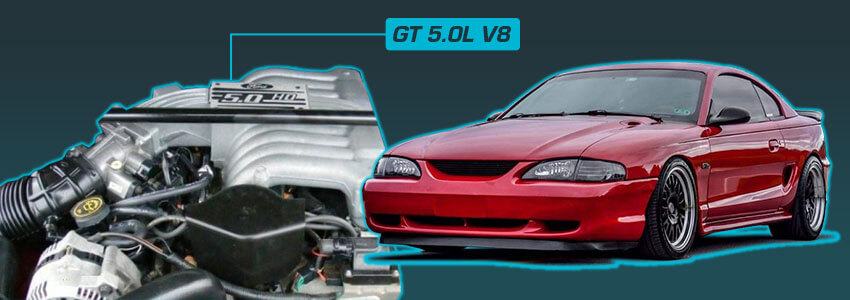
1994-1995 Mustang GT 5.0L V8
Taking valuable lessons from the last few years of the Fox Body Mustang, the SN95 was introduced with a
more modern approach to 5.0L V8 Mustang performance. Using the engine technology and performance learned
from the SVT Cobra and Cobra R in 1993, Mustang engineers were able to sprinkle in some Cobra goodies
into the Mustang GT mass-produced as all Mustang models have been since the 1960s. Starting with a
fuel-injected, efficient, 5.0L V8, Mustang engineers took the engine from potent to lethal. Using GT40
style cylinder heads and a revised intake manifold, the SN95 5.0L V8 was the most influential out of any
pushrod 5.0L to date coming out of a GT model.
Since the introduction of OBD II port, enthusiasts have taken the standard computerized PCM (Power
Control
Module) to integrate more horsepower using fuel mapping and electronic tuning to enhance overall
performance. Furthermore, it used a modern ignition system rather the dated distributor technology,
which would give the 5.0 greater
spark efficiency to increase horsepower and torque distribution throughout all eight cylinders.
Combining this with a T-5 manual transmission, the 94-95 Mustang GT was the most potent to come out of
Detroit since the original GT models of the late 1960s. All of these components combined helped make a
substantial 240 horsepower at 5,000 RPM and a healthy 285 ft/lbs of torque at 4,000 RPM. Ford put their
big boy pants on to make this the start of a long legacy of incredible GT Mustang performance.
Due to the revolutionary progression in Ford engine and drivetrain technology, many enthusiasts have been
known to add performance enhancements such as
revised
cylinder heads, camshafts, and
intake
manifolds. All of
these combined will help the pushrod 5.0L become an
absolute monster whether on the track or the street you will have a pony from hell against any
competition!
You can find the 5.0L Pushrod V8 Engine in the following Mustang models:
- 1994-1995 Mustang GT Coupe
- 1994-1995 Mustang GT Convertible
1994-1995 Mustang 5.0L V8 Specs
| Measurement |
Technical Specification |
| Configuration |
Cast block and Iron heads |
| Intake Manifold |
Aluminum with single runners |
| Exhaust Manifold |
Cast Iron |
| Valvetrain |
16 Valve Pushrod Architecture |
| Pistons |
Cast aluminum |
| Connecting Rods |
Steel |
| Ignition |
Electronic Distributor |
| Bore X Stroke |
4.00 X 3.00 in. |
| Displacement |
302 Cubic Inches/4.0L |
| Compression Ratio |
9.0:1 |
| Engine Control Sytem |
PCM |
| Horsepower |
240 @ 5,000 RPM |
| Torque |
285 LB/FT of Torque @ 4,000 RPM |
| Recommended Fuel |
87 Octane |
| Fuel Delivery |
Fuel Injection |
| Oil Capacity |
Six Quarts 5W-20 w/Oil Filter 5K Mile Intervals |
| Redline |
6,250 RPM |
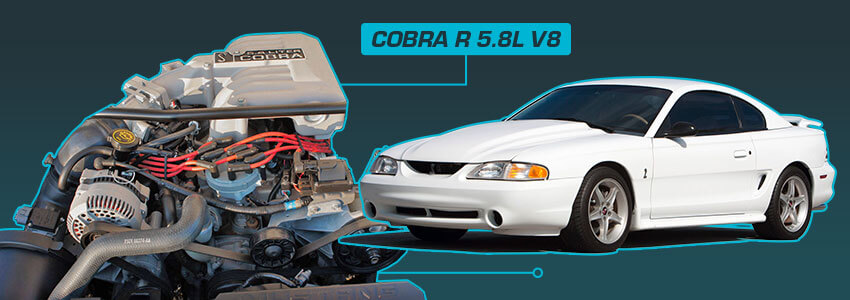
1995 Cobra R 5.8L V8
Just as the final year of the Fox Body came around, Ford knew it had to put together a team that would
incorporate the very best minds of engineering, design, and performance to create the most exceptional
modern interpretation of what a Mustang could be. The 1993 Cobra & Cobra R came to be one of the most
haloed cars Ford ever built. This innovation of American engineering and performance still is seen
throughout the entire landscape of Ford Performance to this very day. It is no wonder that in 1995 Ford
would continue this lineage by producing another Cobra R that would shake the very foundation of what an
American muscle car could be around a road course or autocross. Building upon the success of the very
first
Cobra R in 1993, Ford and SVT (Special Vehicle Team) Engineers worked with a fine-tooth comb to come up
with the most track-capable Mustang to date.
Using Ford's legendary history of building some of the most sophisticated engines on the planet, SVT
engineers got to work to create one of the most poisonous drivers ever made out of Detroit. Built upon a
base of the first generation Ford Lightning engine, the 1995 Cobra R was built with an even more
bulletproof bottom end, revised GT40 style cylinder heads, larger intake manifold, and revised ignition
system. All of this provided the Cobra to produce a staggering 300 horsepower and 365 lb/ft of torque
while retaining the least amount of weight of any Mustang during this year, weighing in at only 3,326
lbs at curb weight. In today's standard, this is insanely light and nimble as the S550 Mustang weighs
almost five hundred pounds more.
You can find the 5.8L Push Rod V8 Engine in the following Cobra models:
1995 Cobra R 5.8L V8 Specs
| Measurement |
Technical Specification |
| Configuration |
Aluminum block and Aluminum heads |
| Intake Manifold |
Aluminum single runner style |
| Exhaust Manifold |
Cast Iron |
| Valvetrain |
OHV 16 Valve Pushrod |
| Pistons |
Cast aluminum |
| Connecting Rods |
Forged Steel |
| Ignition |
Distributor-less with coilpack |
| Bore X Stroke |
4.00 X 3.50 in. |
| Displacement |
351 Cubic Inches/4.0L |
| Compression Ratio |
9.0:1 |
| Engine Control Sytem |
PCM |
| Horsepower |
300 @ 4,800 RPM |
| Torque |
365 LB/FT of Torque @ 3.750 RPM |
| Recommended Fuel |
93 Octane |
| Fuel Delivery |
Fuel Injection |
| Oil Capacity |
Five Quarts 5W-30 w/Oil Filter 5K Mile Intervals |
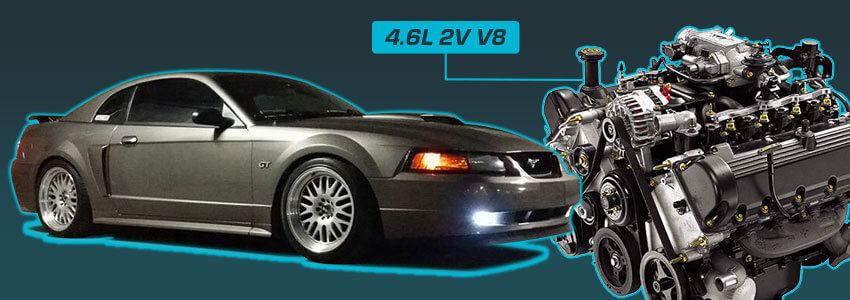
1996-2004 4.6L 2V SOHC V8
Coming into the second half of the 1990s, Ford was at a crossroads to create engine technology that would
revolutionize the American muscle car market amongst its Chevrolet rival. For over two decades, Ford
produced the legendary 5.0 302 pushrod V8 that helped make the Fox Body Mustang so legendary amongst
enthusiasts and the automotive community. To create a more sophisticated Mustang engine, Ford turned to
a Single Overhead Camshaft Design that would allow for higher revving and more
efficient combustion. On the contrary, the new 4.6L 2V V8 used single overhead camshaft to conduct each
valve's timing, unlike the pushrod 5.0 V8 found in most Fox Body Mustangs.
Furthermore, the 4.6L 2V V8 was the first Ford V8 ever to intake a composite intake manifold, which would
help keep intake temps to a minimum vs. older aluminum counterparts. Using an all-new phaser technology
where the timing of the engine would be synchronized with the camshafts, this technology
had only previously been seen on European high-end exotic engines prior. It helped the first modular
engine produce a much efficient power output in 215 horsepower and 285 lb/ft of torque during the first
two years. When the New Edge came about in 1999, it produced 260 horsepower a 45 horsepower increase due
to revised calibration, a new coil plug design, and more efficient fuel delivery. Torque increased to a
tire-shredding 302 lb/ft of torque while maintaining best in class efficiency.
It is evident why Ford went to great lengths in creating the modular engine lineup to create more
efficient horsepower and torque. During this time, many enthusiasts took the aftermarket to maximize the
two valves' potential. Common modifications throughout the Mustang community are a full exhaust,
long-tube
headers, improved
coil packs, larger throttle body, and short-throw shifter to
enable more
drive engagement.
You can find the 4.6L 2V Modular V8 in the following Mustang models:
- 1996-2004 Mustang GT Coupe
- 1996-2004 Mustang GT Convertible
1996-2004 Mustang 4.6L 2V SOHC Modular V8 Specs
| Measurement |
Technical Specification |
| Configuration |
Aluminum block and Cylinder heads |
| Intake Manifold |
Composite shell-welded
Single-runner, charge
motion control valves |
| Exhaust Manifold |
Cast Iron |
| Valvetrain |
SOHC (Single Overhead Camshaft), 3V |
| Valve Diameter/Lift |
Intake: 33.8 mm & Exhaust: 37.5 mm |
| Pistons |
Hypereutectic aluminum |
| Connecting Rods |
Cracked powdered metal
with floating wristpins |
| Ignition |
Coil-on-plug, high-thread-insert
spark plugs |
| Bore X Stroke |
3.55 x 3.54 in. /
90.2 x 90.0 mm |
| Displacement |
281 Cubic Inches/4.6L |
| Compression Ratio |
9.8:1 |
| Engine Control Sytem |
PCM |
| Horsepower |
300 @ 5,750 RPM |
| Torque |
320 LB/FT of Torque @4,500 RPM |
| Recommended Fuel |
87 Octane |
| Fuel Delivery |
Electronic Returnless Sequential Fuel Injection |
| Oil Capacity |
Six Quarts 5W-20 w/Oil Filter 5K Mile Intervals |
| Redline |
6,500 RPM |
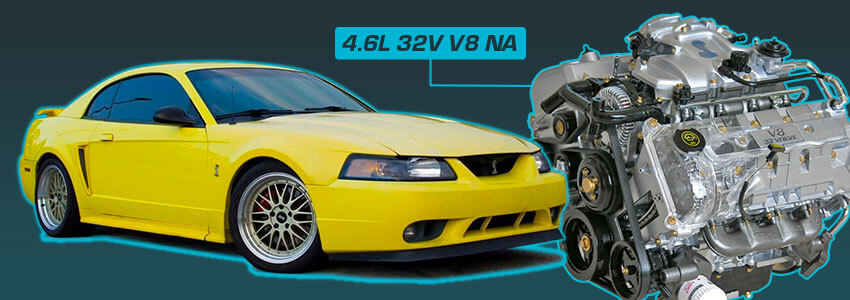
1996-2001 4.6L 32V V8 Cobra
Continuing the Cobra's success, the SN95 and New Edge both received the most sophisticated Ford
engine to
be built since the legendary 427 big blocks found in the Ford GT MKII and the 1967 Shelby GT500
that
helped Carroll Shelby. Ford cements an eternal legacy of all American performance. Using engine
technology only previously found in high-end race cars, the Cobra engines of this era help push
technology forward that is still used in today's lineups of Shelby's and Mustang models alike.
The 32V
DOHC V8 is still revered as one of the most poisonous engines ever fitted in a Cobra to this
day.
Featuring Dual Overhead Camshaft Technology enabled the Cobra to breathe better by allowing more
CFM and
airflow into the engine, which created more combustion in all eight cylinders. During the first
two
years of the Modular Cobra, they came equipped with B shaped cylinder head. This is what helped
the
engine breathe so much better to create more horsepower than the outgoing pushrod Windsor based
V8
models. With all the substantial increased airflow, the 96-98 modular Cobra engines were able to
make
305 horsepower at 5,800 RPM and 300 lb/ft of torque at 4,800 RPM. It is no wonder why having
DOHC (Dual
Overhead Camshaft) technology is far superior to pushrod tech due to the amount of airflow the
cylinder
head can deliver to each combustion chamber.
In 1999, Ford, yet again, realized they had to step up to the plate back to deliver even more
performance. Using a Teksid engine block, this created a much more rigid foundation for the
Cobra;
Mustang engineers wanted to take it even a step further to unleash the full potential of the
4.6L 32V
Modular V8. By revising engine calibration and retooling the cylinder heads known as "C" shape,
they
were able to increase horsepower by 15 by adding more airflow and timing to the mix. Throughout
the
Mustang community, it is regularly known that long-tube
headers, lowering
springs, and a larger throttle body will be
added to increase overall performance and driving experience.
You can find the 4.6L 32V V8 in the following Cobra models:
- 1996-2001 Cobra Coupe
- 1996-2001 Cobra Convertible
1996-2001 Cobra 4.6L 32V V8 Specs
| Measurement |
Technical Specification |
| Configuration |
Aluminum block and Aluminum heads |
| Intake Manifold |
Cast Aluminum |
| Exhaust Manifold |
Cast Iron |
| Valvetrain |
DOHC (Dual Overhead Cam), 32V |
| Pistons |
Forged Aluminum |
| Connecting Rods |
Forged |
| Ignition |
Distributor-less coil on plug design |
| Bore X Stroke |
3.55 in. x 3.54 in. |
| Displacement |
281 Cubic Inches/4.6L |
| Compression Ratio |
9.85:1 |
| Engine Control Sytem |
PCM |
| Horsepower |
320 @ 6,000 RPM |
| Torque |
317 LB/FT of Torque @ 4,750 RPM |
| Recommended Fuel |
93 Octane |
| Fuel Delivery |
Electronic Fuel Injection |
| Oil Capacity |
6 quarts 5W-20 w/Oil Filter 3K Mile Intervals |
| Redline |
6,250 RPM |
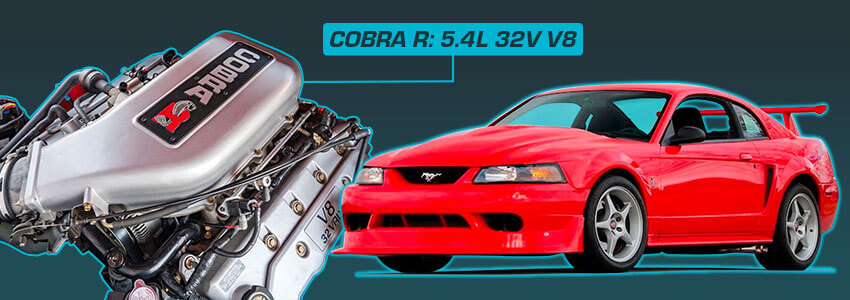
2000 5.4L 32V V8 Cobra R
At the turn of the millennia, Ford knew that to keep up the success of SVT (Special
Vehicle Team)
and the Cobra, it would have to pull every asset out of the bag to hit the automotive
world
upside down. After months and months of work, Mustang and SVT designers and engineers
debuted
the 2000 Cobra R; this sadistic snake was the most potent batch of venom ever to hit
Ford
showrooms. Using Ford's long-standing racing pedigree, SVT engineers were able to put
forth a
beast that would challenge anything Chevrolet, or its European rivals could come up
with.
Starting with a base New Edge chassis, that is where all the similarities stop.
Starting with the New Edge chassis, SVT and Mustang engineers got the right to build the
most
potent Cobra to date. Using the basis of the modular 32V V8 engine, SVT engineers
thought it
would be best to enlarge the engine size to a behemoth 5.4L or 330 cubic inches. It
would enable
the Cobra to create existential horsepower whenever it needed to. Furthermore, by using
modern
technology, Ford could use a couple of tricks up their sleeves to create a one-off
intake
manifold that would allow the Cobra R to have more free-flowing revving while
maintaining
horsepower efficiency across the board.
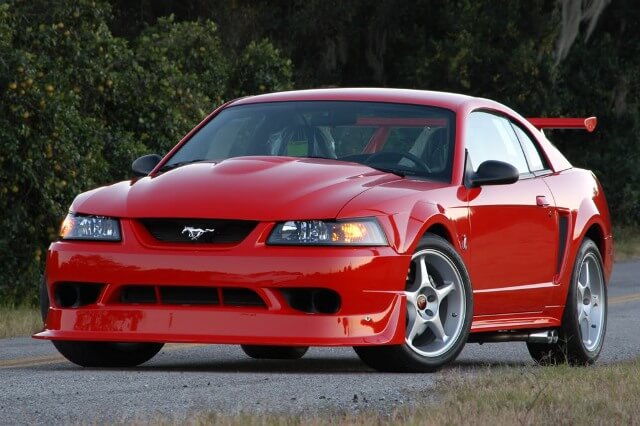
Learning lessons from previous Cobra models, engineers were able to pull maximum
horsepower by
adding more CFM to each cylinder head while giving it proper calibration and timing to
create
385 horsepower 6,250 RPM and 385 lb/ft of torque 4,250 RPM. At this time, it had been
the most
powerful naturally aspirated engine to come from the blue oval. To harness all this
power, the
Cobra R used a Tremec T-56 transmission to help translate all those 385 venomous ponies
to get
to the ground efficiently. Unlike past Cobra R models, the New Edge was the first to
feature
high-flow side exit exhaust featuring a Bassani x-pipe, which aided in making all that
potent
venom.
Looking at the 2000 Cobra R from today's crazy standard of monstrous Mustang and Shelby
performance. Twenty years ago, it was the king of all factory-built track cars at that
time.
Ford knew that it was so unique, it why only three-hundred were built to make it an
exclusive
club among Mustang enthusiasts and owners. Each one was painted in Performance Red and
was only
equipped with the necessary needs to go racing on the track. Creature comforts such as
air
conditioning, radio, power windows, locks, and back seat were all deleted in the aiding
of
saving weight for better handling at the track.
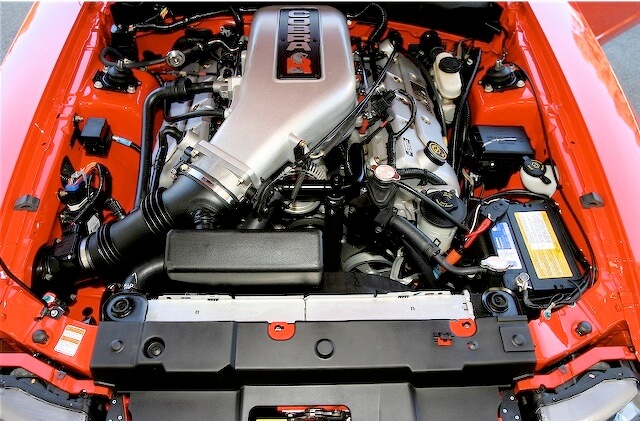
You can find the 5.4L 32V V8 Engine in the following Cobra models:
2000 Cobra R 5.4L 32V V8 Specs
| Measurement |
Technical Specification |
| Configuration |
Aluminum block and Aluminum heads |
| Intake Manifold |
Aluminum Cobra R specific long runner high revving |
| Exhaust Manifold |
Cast Iron |
| Valvetrain |
DOHC (Dual Overhead Cam), 32V |
| Pistons |
Forged Aluminum |
| Connecting Rods |
Forged H-Beam |
| Ignition |
Distributor-less coil plug design |
| Bore X Stroke |
3.55 in. x 4.17 in. |
| Displacement |
330 Cubic Inches/5.4L |
| Compression Ratio |
9.6:1 |
| Engine Control Sytem |
PCM |
| Horsepower |
385 @ 6,250 RPM |
| Torque |
385 LB/FT of Torque @ 4,250 RPM |
| Recommended Fuel |
93 Octane |
| Fuel Delivery |
Electronic Fuel Injection |
| Oil Capacity |
8.5 Quarts 15W-50 Full Synthetic w/Oil Filter 3K Mile Intervals |
| Redline |
6,500 RPM |
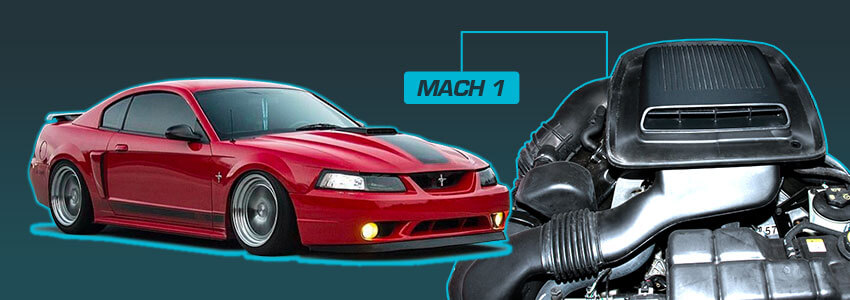
2003-2004 Mach 1 4.6L 32V V8 "Shaker"
In the Mustang community, few models are more synonyms as Mach 1, sleek lines, and wide
stance
give it a look that helps it feels it's going 100 MPH standing still. It was nearly
thirty-five
years that a Mach 1 had been available to enthusiasts, so Ford knew it was pivotal to
bring an
iconic nameplate back to the Mustang lineup. Using many lessons learned from SVT and the
past
Cobra models, engineers would implement the 4.6L 32 valve V8 that had been a significant
success
since 1996. To give it the trademark Mach 1 treatment of style and performance, Mustang
engineers made it a critical priority to design a modern interpretation of ram-air
"Shaker"
performance to give it the signature muscle a Mach 1 deservers but increase the
efficiency of
the modular engine.
With the combination of revised cylinder heads and the stout aluminum modular block, the
Mach 1
became the little brother to the infamous Terminator. This stallion produced a whopping
305
horsepower at 5,800 RPM and 320 lb/ft of torque at 4,200 RPM; customers could choose
from a
four-speed automatic transmission or a 5-speed Tremec
TR-3650 which any
enthusiast would tell you is the one to have. Bringing everything together between the styling,
striping, and all-out performance, the New Edge Mach 1 did a lot of justice to pay respects to
its original counterpart. Throughout the years, Team Steeda has seen many enthusiasts upgrade their
2003-2004
Mach 1 with a Vortech
Supercharger, long-tube headers, and upgraded suspension
to enhance the
driving experience.
We are very much looking forward to what the all-new 2021 Mustang Mach
1
has to offer in the coming year. It will be exciting if it can live up to its predecessors like the New
Edge did to
the 1969 and 1970 Mach 1 Fastback.
You can find the " Shaker" 4.6L 32V V8 Engine in the following Mustang models:
2003-2004 Mustang Mach 1 Shaker 4.6L 32V Specs
| Measurement |
Technical Specification |
| Configuration |
Aluminum block and heads |
| Intake Manifold |
Composite single runner Shaker |
| Exhaust Manifold |
Cast Iron |
| Valvetrain |
DOHC 32 Valve |
| Pistons |
Cast aluminum |
| Connecting Rods |
Forged |
| Ignition |
Distributor-less with coil on plug design |
| Bore X Stroke |
90.2mm X 90mm |
| Displacement |
4.6L/281 Cubic Inches |
| Compression Ratio |
10.1:1 |
| Engine Control Sytem |
PCM |
| Horsepower |
305 @ 5,800 RPM |
| Torque |
320 LB/FT of Torque @ 4,200 RPM |
| Recommended Fuel |
93 Octane |
| Fuel Delivery |
Electronic Fuel Injection |
| Oil Capacity |
Six Quarts 5W-20 w/Oil Filter 3K Mile Intervals |
| Redline |
6,500 RPM |
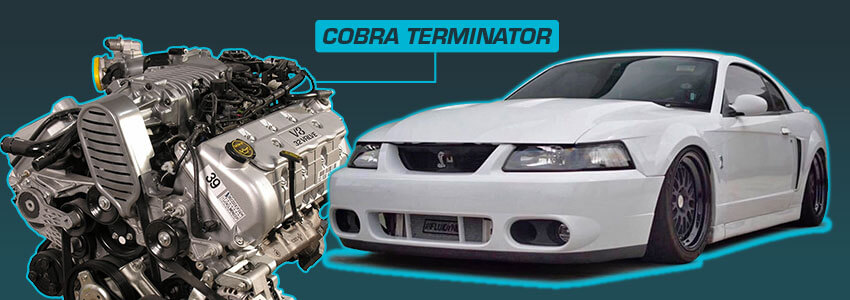
Cobra "Terminator" 4.6L 32V Supercharged V8
In the history of modern American muscle and Mustangs, there isn't a more famous
model
than the 2003-2004 Terminator Cobra. This venomous beast from hell is still
today
revered as one of the most mental and craziest creations ever to come out of
Dearborn.
In the American automotive community, it has been said the Camaro stopped
production
solely to how the Cobra took the world by storm. Unlike all the previous Cobra
models in
past years, the "Terminator" was the first to feature a roots style supercharger
of 1.9L
forcing as much air and fuel into the hand-built 4.6L 32V V8 to create a
staggering 390
horsepower at 6,000 RPM and 390 lb/ft of torque at 3,500 RPM. During the early
2000s, it
was one of the most potent and obscene sports coupes on the planet. Some say in
the
enthusiast community that some Terminator engines made more power than others,
for
instance, in a case found, an owner could pull 420 horsepower stock out of the
engine
when running on the dynamometer.
It truly began a trend for all other competition to follow, including the
successors it
would have like the 2007 Shelby GT500, Shelby GT350R, and 2020 Shelby GT500.
All of
these incredible beasts from SVT and Ford Performance are a tribute to the
engineering
and prowess that the Terminator legacy started. Like its predecessors, the
Terminator
began the notion that significant power is easy to come by with a few simple
modifications. Since each Terminator engine was hand-built, many enthusiasts
never knew
how much power they were getting. Due to this, the Mustang community still
aspires to
own the most famous Cobra ever built other than the 2000 Cobra R.

While the Cobra faithful enjoyed 390 horsepower from the factory, enthusiasts can
never
leave anything alone. To push the Terminator even further, we have seen limits
being
pushed by bolting on a massive Whipple Supercharger, mono blade
throttle body,
long-tube
headers, custom
tune,
exhaust and
twin-disc clutch to
handle upwards of over 600 horsepower to
the wheels. Some have even been to make almost 800 horses with factory internal
components with proper tuning and fuel management.
Unlike the previous Cobra models, the 2003-2004 Cobra came equipped standard with
Tremec's infamous T-56 6-speed manual transmission, which was
Ford's first entry into a six-speed gearbox in any vehicle from the factory. It
provided
much need support in the
driveline to efficiently and smoothly get all those lethal ponies to the ground.
Chances
are if you're at your local car meet or show you can spot a Terminator just by
the
immense supercharger whine coming from far down the road. At Steeda, we still
think this
is one of the baddest additions to every hit the Mustang lineup in history!
You can find the "Terminator" 4.6L 32V Supercharged V8 Cobra models:
- 2003-2004 Cobra "Terminator"
- 2003-2004 Cobra "Terminator" Convertible
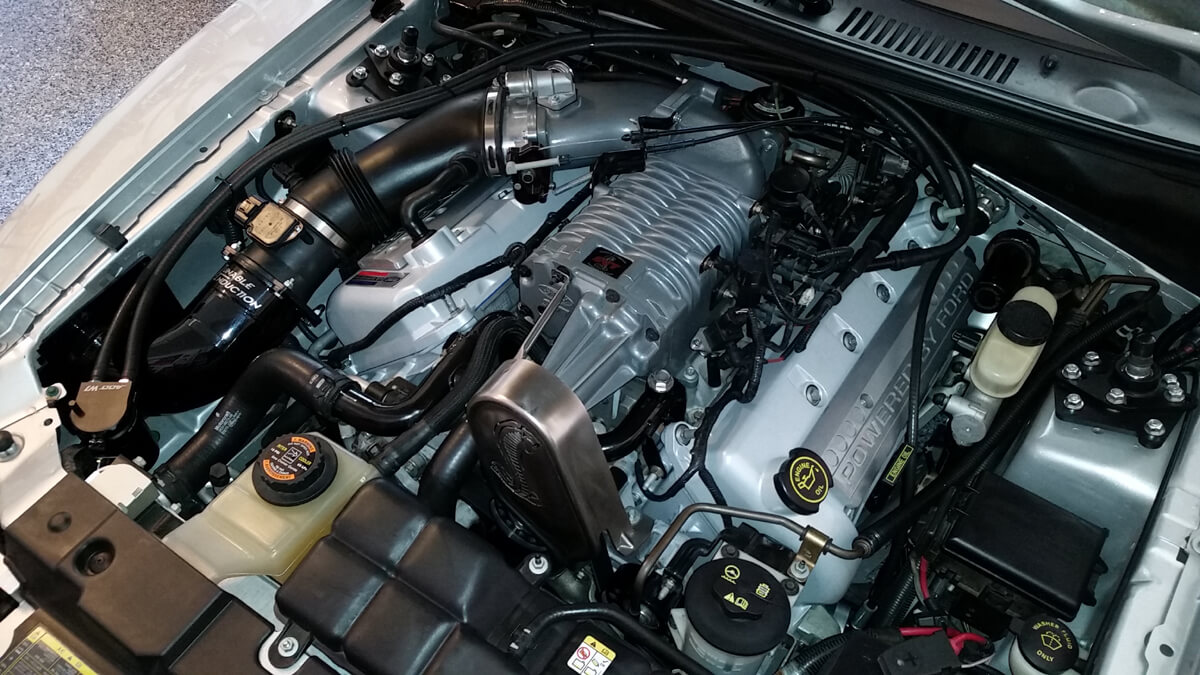
Cobra "Terminator" 4.6L 32V Supercharged V8 Engine Specs
| Measurement |
Technical Specification |
| Configuration |
Cast aluminum block and heads |
| Intake Manifold |
1.9L Eaton Roots Style Supercharger |
| Exhaust Manifold |
Cast Steel headers |
| Valvetrain |
DOHC 32V |
| Pistons |
Cast aluminum |
| Connecting Rods |
Forged aluminum |
| Ignition |
Distributor-less with coil on plug design |
| Bore X Stroke |
3.55 in X 3.54 in |
| Displacement |
4.6L/281 Cubic Inches |
| Compression Ratio |
11.0:1 |
| Engine Control Sytem |
PCM |
| Horsepower |
390 @ 6,000 RPM
|
| Torque |
390 LB/FT of Torque @ 3,500 RPM |
| Recommended Fuel |
93 Octane |
| Fuel Delivery |
Electronic FUel Injection |
| Oil Capacity |
6.5 quarts 5W-30 Full Synthetic (3,000-mile service interval) |
| Redline |
6,500 RPM |

Related
Articles
Image Credit: Ford Motor Company, Ford
Performance, SVT Performance

















